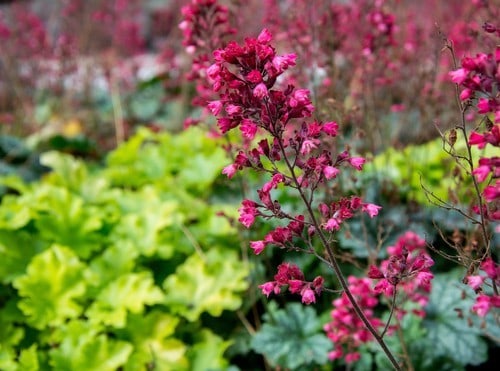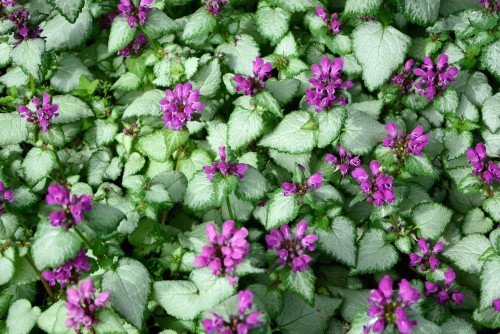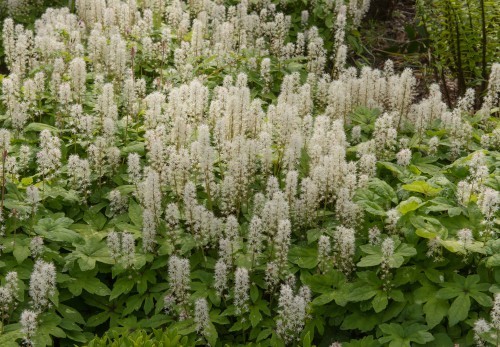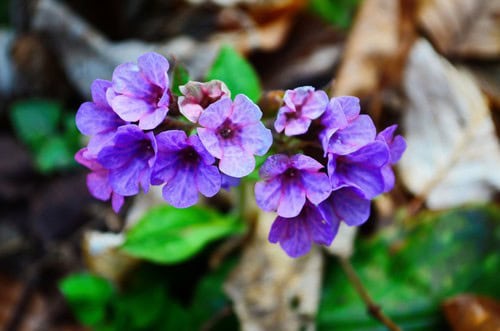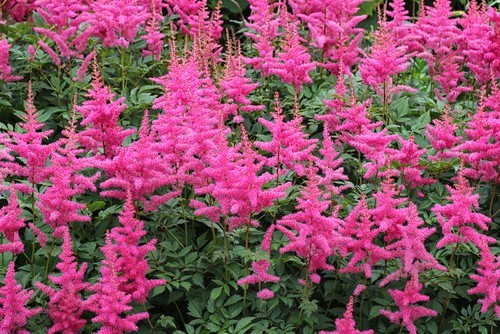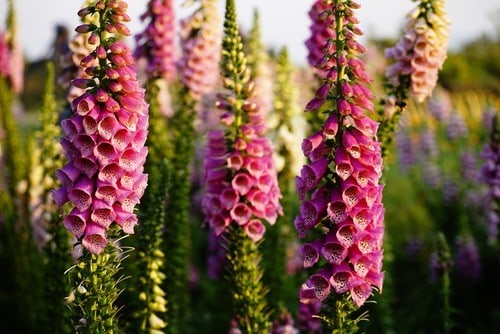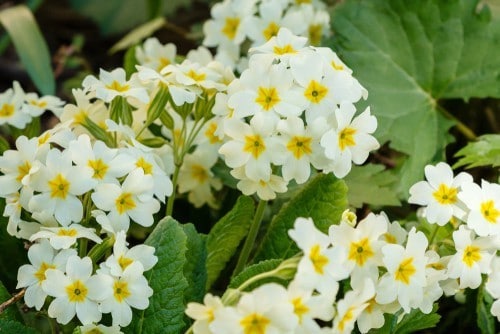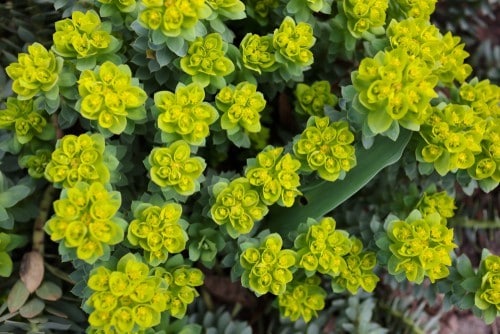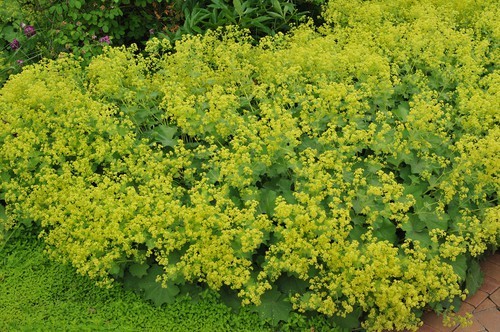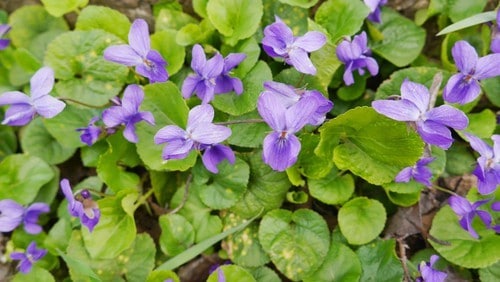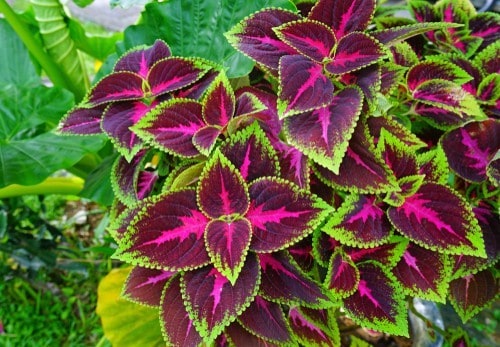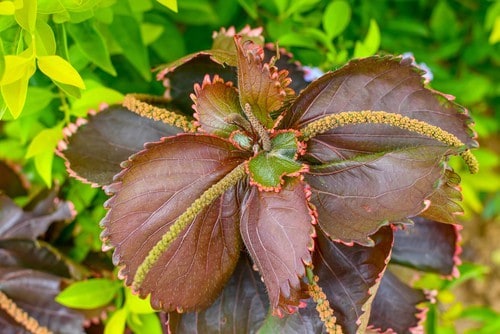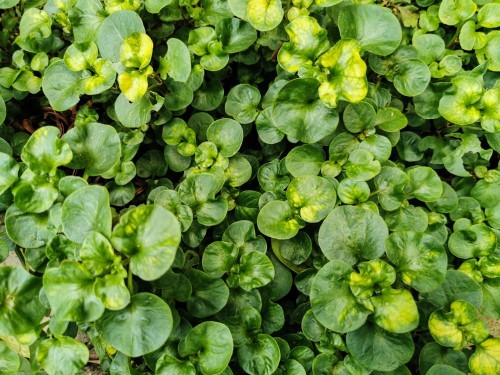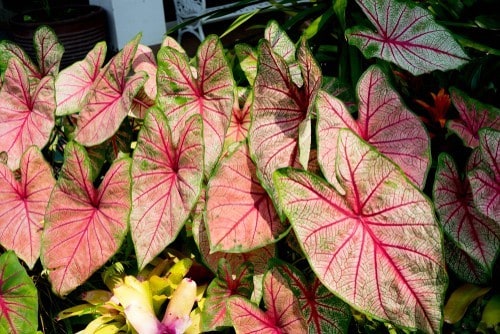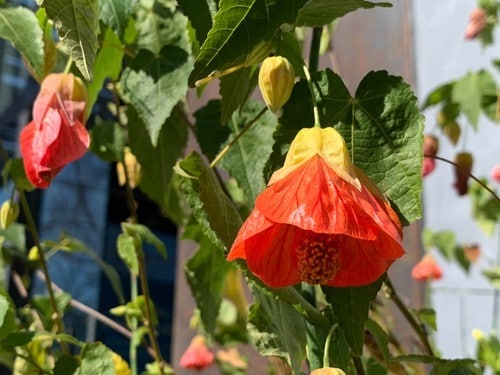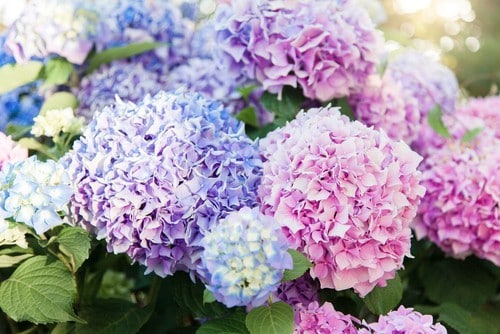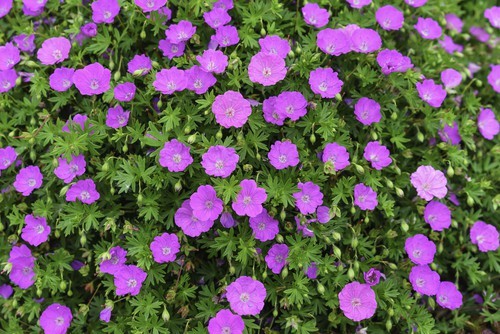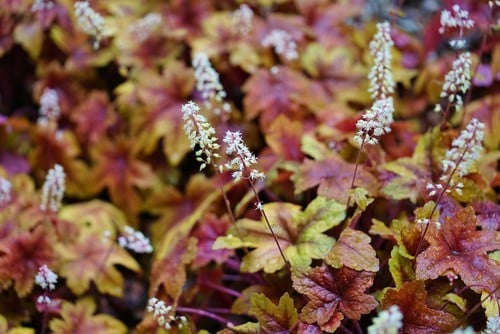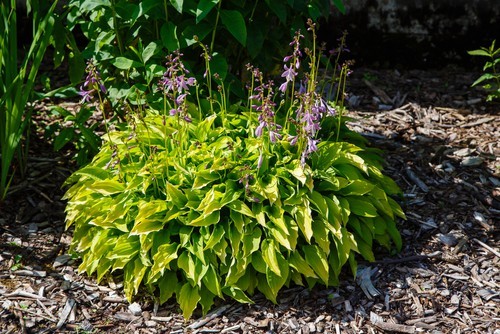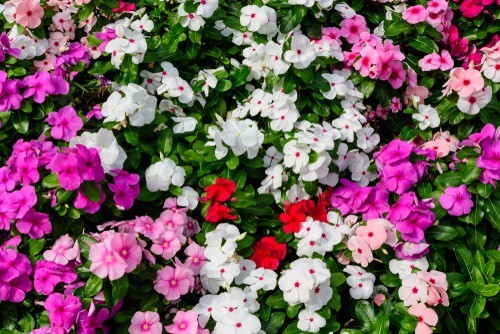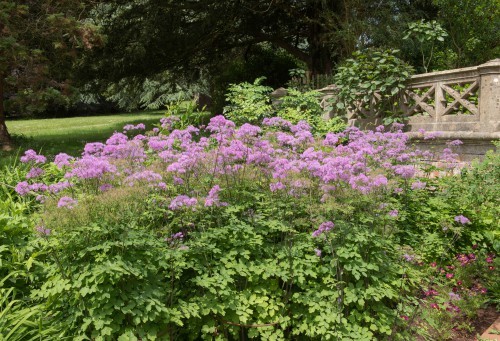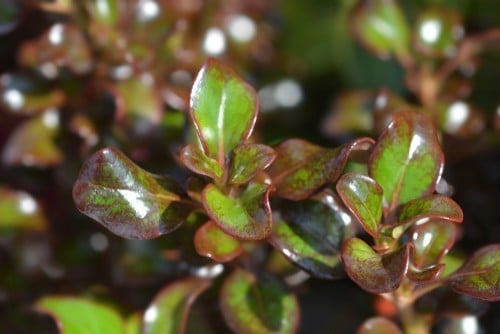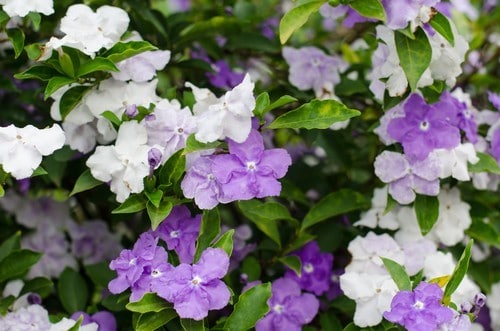If you’re like many homeowners, you may have areas in your yard that receive little to no sunlight, making it challenging to grow plants there. I’m no stranger to these shaded spots myself, having struggled with them in my own yard. But don’t worry, because today I’ll be sharing a list of plants that are perfectly suited for growing in shade. My goal is to inspire you to find creative solutions for your own troublesome areas, bringing beauty and vibrancy back into your outdoor space.
Coral Bells
With its vibrant blooms and effortless growth habit, this stunning perennial is a perfect addition to any shade-dwelling garden. Its low-maintenance requirements mean you can simply sit back and enjoy the show as it thrives year after year. Whether you’re looking for a pop of color or a reliable return on your horticultural investment, this beautiful flowering plant has got you covered.
Dead Nettle
The addition of a perennial with vibrant colors and foliage can greatly enhance the ambiance of shaded areas in your garden. One such option is [Image via Shutterstock], which boasts stunning hues and lush growth. However, it’s essential to consider that this particular choice serves as a ground cover, propagating roots and stems as it spreads. If you’re not keen on having something spread through your yard, albeit adding beauty and color, you may want to explore alternative options.
Foam Flower
With its intriguing name, this perennial flower is sure to catch the eye. But it’s not just the name that makes it stand out – the blooms themselves are a sight to behold. Rather than spreading out as a ground cover, each stem produces numerous individual flowers, creating a visually striking display. The colors on offer are equally impressive, making this a great choice for adding a pop of color to a shady area.
Lungwort
This enigmatic plant thrives in shaded environments. Its name, derived from its perceived resemblance to a lung, has an intriguing history. Believed to possess healing properties, ancient cultures attempted to harness its medicinal powers for treating lung disease. Although it proved ineffective, the name persisted. Interestingly, this perennial plant is notorious for its ability to spread rapidly and form dense clusters.
While not ideal for those seeking a low-maintenance ground cover, it does boast a unique advantage: it’s one of the few plants that can coexist with the toxic Black Walnut tree, making it an excellent choice for gardeners looking to create a harmonious undergrowth around their arboreal friends.
Astilbe
A stunning perennial, often shrouded in shade, harbors a unique charm that’s worth exploring. Its allure extends beyond its delicate petals, as it serves as a magnet for butterflies. When planted, this beautiful bloom attracts these winged wonders, adding an enchanting dimension to any outdoor space or flower arrangement.
Foxglove
In contrast to other perennials, foxgloves exist in a state of limbo when it comes to their regenerative habits. While they don’t reliably return year after year like some annuals do, they still possess the ability to self-seed, which ultimately enables them to persist and even thrive over time.
This unique quality makes foxgloves an attractive option for gardeners seeking a plant that will not only provide a splash of vibrant colors but also return annually.
Their reseeding capabilities ensure that each year’s bloom is followed by the promise of another stunning display, making them an excellent choice for those looking to add some visual interest to their outdoor spaces.
Japanese Forest Grass
The Japanese Forest Grass is a captivating perennial that requires minimal maintenance. Unlike other plants, you only need to plant it once and enjoy its unique charm. Its grassy appearance resembles a fluffy pom-pom, adding a subtle touch to shaded areas without overwhelming with vibrant colors. For those seeking a finishing touch for their shaded space without introducing a kaleidoscope of hues, this grass is an excellent choice.
To ensure optimal growth and health, consider providing the best possible fertilizer to support its development.
Primrose
With their vibrant hues and hardy nature, primroses can either bloom as annuals or perennially return year after year. If you find that they’re not quite the right fit for your garden, it’s easy to remove them without making a long-term commitment. But once you’ve experienced their cheerful colors and frost-hardiness firsthand, you may just decide to make room for them in your permanent floral lineup.
Spurge
Spurge, a versatile flowering plant, offers a unique characteristic – its ability to thrive as either a perennial or annual, depending on the climatic conditions. In frost-free zones, it can remain year-round, while in colder regions, it tends to be an annual. Regardless of its growth cycle, spurge is renowned for its breathtaking beauty and capacity to inject life into shaded spaces.
For those seeking a plant that flourishes in shade and refrains from adding vibrant hues, but still provides a splash of color to their outdoor areas, spurge is definitely worth considering.
Lady’s Mantle
Lady’s Mantle, a perennial with understated charm, can be used in various ways. Some people appreciate its simplicity by incorporating it into decorative wreaths, while others enjoy its subtle beauty as a décor element. Another use is as a live edging, although this requires regular maintenance due to its ground-covering nature.
While Lady’s Mantle may not boast flashy features, its classic elegance and simple green vines make it an excellent choice for adding character to shady areas in your garden or yard. Its understated beauty can bring a sense of serenity to any outdoor space.
Browallia Hybrid
One of the most convenient aspects of this plant is its ability to thrive in a variety of settings. It’s an excellent option for those who want a ‘set it and forget it’ type of arrangement, as it requires minimal maintenance. The plant has a natural tendency to mound when planted directly in the soil, but it can also be successfully used in flower boxes or vases.
Moreover, its exceptional heat tolerance allows it to flourish in locations with direct sunlight, partial shade, or even full shade – making it an incredibly versatile addition to any outdoor space.
Coleus
Coleus, a tender perennial, requires a unique approach to encourage its growth. To stimulate larger, stronger foliage, gardeners must employ the technique of pinching. Despite this need for special care, coleus thrives in shaded environments, showcasing stunning dark and rich colors. For those seeking a low-maintenance yet colorful addition to their outdoor spaces, coleus offers an attractive solution.
Copper Plant
A stunning annual plant, the Copper Plant boasts breathtaking foliage in a kaleidoscope of colors. While it can thrive in shaded areas, its true beauty is unlocked when it’s basked in the warmth of the sun. If you have a spot that receives a mix of shade and sunlight, this plant may still flourish there. However, its delicate nature requires attentive care to keep pests at bay and coax it to reach its full potential.
Creeping Jenny
Creeping Jenny is a hardy perennial that boasts the ability to thrive year after year. In fact, depending on your location and zone, it may even retain its vibrant green hue throughout the year’s seasons. As a low-growing ground cover, Creeping Jenny has a natural tendency to spread and fill in spaces, making it an excellent choice for shaded areas. However, this same propensity can also lead to it becoming overbearing if left unchecked.
As such, it’s essential to consider your goals when planting this species – do you want it to dominate the landscape or create a lush, even cover?
Fancy-Leafed Caladium
From Shutterstock, an image captures the essence of the plant in question. With this variety, you have the freedom to either cultivate it from bulbs or procure new ones annually from a reputable nursery. Regardless of your approach, these vibrant blooms will undoubtedly bring a pop of color to your shaded area.
Flowering Maple
The Flowering Maple, an annual for many of us, thrives under filtered sunlight and a temperature range of 70° during the day to 60-65° at night. For those residing in tropical climates, they may be fortunate enough to enjoy this plant’s beauty year-round without the need for repeated purchases or indoor potting. However, for those living outside these warm regions, it’s likely that the Flowering Maple will require annual replacement or repotting to protect it from harsh winter temperatures.
Despite these conditions, the stunning flowers produced by this plant are undoubtedly worth the extra effort.
Garden Hydrangea
Perennials like Garden Hydrangeas offer a fantastic option for adding some vibrancy to shaded areas of your garden. One of the things I love about these plants is the incredible variety of colors they now come in, which makes them truly stunning and perfect for bringing a touch of subtle color to darker spaces.
Geranium Cranesbill
Geranium Cranesbill, a perennial by nature, offers a unique advantage – once planted, it will thrive for years to come without requiring repeated efforts. One of its most appealing qualities is its consistent blooming pattern throughout the season, unlike some flowers that only display their beauty for a brief period before going dormant.
With Geranium Cranesbill, you can expect a constant parade of color and vibrancy in your shaded garden, adding a touch of elegance to your outdoor space without fail.
Heucherella
Heucherella, a captivating hybrid, was born from the union of Coral Bells and Foam Flowers. Its striking appearance mimics that of a vine, with diverse colored blooms bursting forth. For those seeking a shaded ground cover, Heucherella is an intriguing option. This versatile plant offers the added benefit of combining two distinct species into one, making it a valuable addition to any garden.
Hosta
With the backdrop of a serene Shutterstock image, my affection for Hostas is no secret. These low-maintenance plants have earned a special spot in my garden, where they thrive with minimal effort. Their adaptability to grow almost anywhere is what makes them so appealing – and I’m not alone in this sentiment. Whether your outdoor space is in need of a revamp or you’re looking for a solution that’s easy on the hands (and eyes), Hostas are an excellent choice.
As perennials, they’ll return year after year, growing larger and more vibrant with each passing season.
Impatiens
While many gardeners cultivate impatiens as annuals, this versatile plant also offers a perennial option. Interestingly, the majority of impatiens grown are the annual variety, which allows enthusiasts to bask in their beauty during the summer months. The perennial type, on the other hand, typically flourishes during the US winter season. If you appreciate showy, mounded blooms, chances are you’ll find Impatience a delightful addition to your garden.
Meadow Rue
Meadow Rue, a perennial beauty, thrives in swamp-like environments and shaded wooded areas. Its delicate appearance belies its hardiness, with pastel hues adding a touch of elegance. What’s more, this lovely flower boasts natural resistance to diseases and pests, making it an attractive addition to any garden. However, to keep Meadow Rue healthy and thriving, ensure consistent moisture levels – avoiding overwatering that can lead to rust development.
Mirror Plant
From the iconic cottage-style gardens, Mirror Plants have earned their reputation as perennials that bring a pop of color to any outdoor space. With blooms ranging from crisp white to soft pinks and rich purples, they’re an ideal choice for adding a touch of elegance to shaded areas. Whether you’re looking to create a whimsical oasis or simply add some visual interest to your garden, Mirror Plants are sure to delight.
Persian Shield
While Persian Shield may thrive as a perennial in zones 8-11, it’s still possible to enjoy its subtle charm elsewhere. Simply move it outdoors during warmer months and bring it indoors over winter. However, with some extra care, this stunning plant can stay beautiful all year round, regardless of your location.
Yesterday-Today-And Tomorrow
With a nod to Shutterstock, I recently discovered this enigmatic shrub. Like many hardy plants, it can thrive as a perennial in the right zones. However, if you reside in an area prone to frost, it will require potting and indoor relocation to ensure its survival. The blooms of this plant are nothing short of breathtaking, emitting a sweet fragrance that’s simply irresistible.
As we wrap up today’s exploration, I’m delighted to share with you 25 remarkable options for shade-loving plants, shrubs, and ground coverings that can bring a touch of life to even the most shaded areas of your garden or yard.
